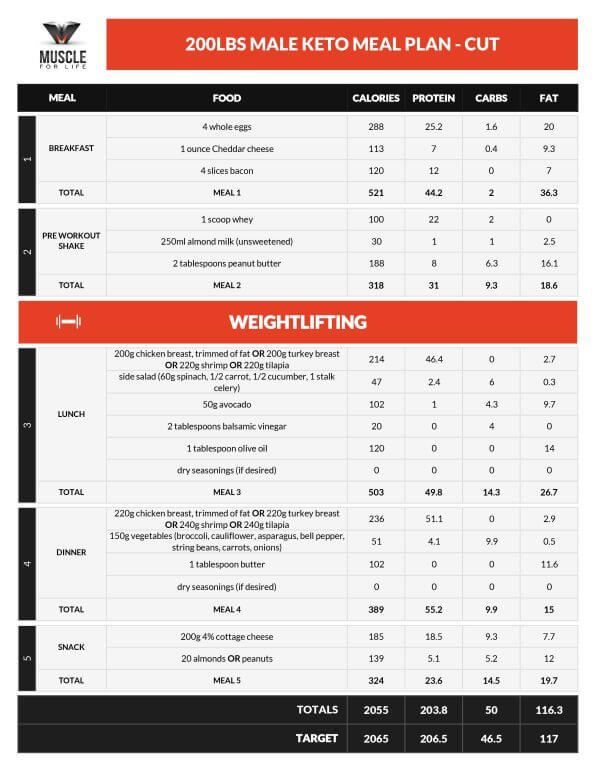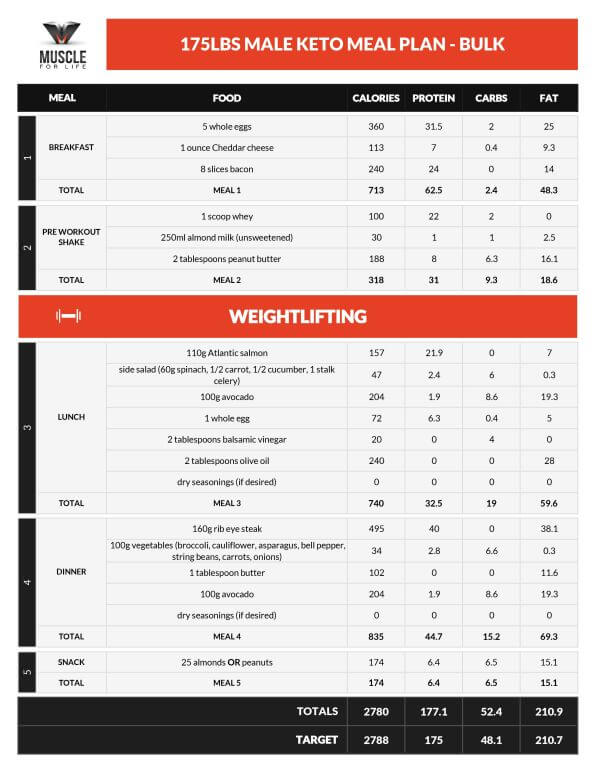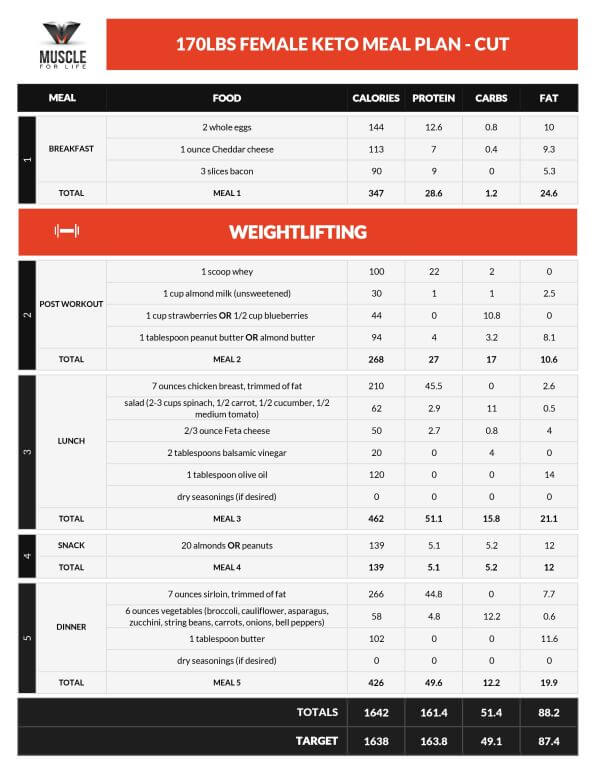Key Takeaways
- Some claim that low-carb, high-fat diets are better than high-carb diets for losing fat, building muscle, and increasing your endurance.
- The truth is that high-fat diets are no better for losing fat, probably worse (or no better) for building muscle, and much worse for increasing your endurance.
- That said, you may benefit from following a high-fat diet if you’re overweight and sedentary, you struggle with hunger when following a high-carb diet, and/or you’re tired of high-carb dieting.
Everyone loves a good controversy.
And the more it seems we’ve been “wrong all along,” the more exciting it is when we discover the truth.
That’s why we salivate at stories like . . .
“Why running is bad for your health.”
“Why grains are unhealthy.”
“Why dieting makes you fat.”
And recently, the exposé du jour has been that low-fat, high-carb diets—the ones we’ve all been told are healthy—are actually making us fat, sick, and weak.
Not only that, but low-carb, high-fat diets have a number of advantages over high-carb diets, we’re told. People claim that high-fat diets are better for . . .
- Fat loss, because they make you burn more fat, increase your metabolic rate, and help you eat less.
- Building muscle, because fats are better utilized for muscle growth than carbs (which, it’s claimed, just raise insulin and make you fat and sluggish).
- Endurance sports, because they teach your body to run on fat, not carbs, so you can go farther and faster before becoming fatigued.
That’s what the Internet says, at least.
Should we listen, though?
Well, in a word, no.
The long story short is that there are situations where high-fat diets might be helpful, but they’re few and far between. If your goal is to lose fat, build muscle, and stay healthy, you’re generally better off following a high-carb diet, not a high-fat one.
Before we get into all of that, let’s look at what a high-fat diet actually is.
(Or if you’d prefer to skip all of the scientific mumbo jumbo, and you just want to know how many calories, how much of each macronutrient, and which foods you should eat to reach your health and fitness goals, no problem! Just take the Legion Diet Quiz, and in less than a minute, you’ll know exactly what diet is right for you. Click here to check it out.)
- What Is a Low-Carb, High-Fat Diet?
- Low-Carb, High-Fat Diets and Fat Loss
- Low-Carb, High-Fat Diets and Building Muscle
- Low-Carb, High-Fat Diets and Endurance Sports
- Who Should Follow a High-Fat Diet and Who Shouldn’t
- The High-Fat Diet Menu
- How to Create a Low-Carb, High-Fat Diet Plan
- The Bottom Line on Low-Carb, High-Fat Diets
Table of Contents
+What Is a Low-Carb, High-Fat Diet?
A high-fat diet is a diet in which most of the calories come from fat, rather than carbohydrate or protein.
Not very specific, huh?
This brings us to one of the first problems when comparing high-fat and high-carb diets. Different studies, diet book authors, and gurus define “high fat” in different ways.
Some high-fat diets are also high-protein and some aren’t.
Some allow a reasonable amount of carbs, but keep it lower than the current dietary guidelines of about 45 to 65% of calories.
Some high-fat diets, like the traditional ketogenic diet, are low-protein, low-carb, and 80+% fat.
You have to draw the line somewhere, though, so I’ll go with this definition for now:
A high-fat diet is any diet where the majority of calories come from fat instead of carbohydrate or protein.
High-fat diets usually look more or less like a ketogenic diet, and as you can guess, they’re often used for the same goals, such as fat loss.
Let’s see how they do in that regard.
Low-Carb, High-Fat Diets and Fat Loss

You’ve probably heard that the fastest, most effective, and enjoyable way to lose weight is to cut your carb intake.
No surprise there, low-carb diets have been in vogue for a while.
Replace much of your daily carb intake with fat, and you’ll be able to eat less and lose weight faster, they say.
Others say there’s more to the story.
They claim that fat is more than just a substitute for carbs, and that eating more fat directly causes your body to burn more fat.
All in all, the arguments in favor of high-fat diets really boil down to four main points:
- “Eating more fat helps you lose weight much faster.”
- “Eating more fat helps you burn more body fat.”
- “Eating more fat helps you burn more calories”
- “Eating more fat helps you eat less.”
Is any of this true, though?
Let’s find out.
Low-Carb, High-Fat Diet Myth #1: “Eating more fat helps you lose weight much faster.”
Let’s start with the most common and controversial claim about high-fat diets:
That they help you lose weight faster.
This simple idea has been the basis for hundreds of diet books, weight loss programs, and scientific papers, and high-fat diet proponents can point to study after study that seems to prove they’re right.
It’s also not uncommon for people to lose 5, 10, or 20 pounds after switching to a high-fat diet.
So, it must be better for weight loss, right?
Nope.
Why not, you wonder?
The first thing you need to know is how carbohydrate intake relates to glycogen storage and water retention.
High-Fat Diets, Glycogen, and Weight Loss
Glycogen is a form of glucose stored in the liver and muscle tissues and the primary dietary source of glucose is carbohydrate.
This is why research shows that increasing carbohydrate intake increases glycogen storage and reducing intake reduces glycogen levels.
Here’s the catch, though: glycogen is stored with three to four parts water. That means that every gram of glycogen stored comes with three to four grams of water.
When you consider that the average man can store up to 15 grams of glycogen per kilogram of body weight, and that exercise increases the glycogen storage capacity of muscle, you see how much weight can change due to fluctuations in glycogen levels alone.
For instance, I weigh about 82 kilograms (180 pounds) and have quite a bit more muscle than the average man, and I exercise regularly, and I eat a relatively high-carbohydrate diet (300+ grams per day).
It’s hard to predict exactly how much glycogen I’m holding, but a “safe” assumption is 700 to 800 grams, and that means I’m also holding 2,100 to 2,400 grams of water. This is a grand total weight of 2,800 to 3,200 grams, or 6 to 7 pounds.
Now, what do you think would happen if I switched to a high-fat diet, dramatically reducing my carbohydrate intake?
That’s right—I would also see a dramatic reduction in whole-body glycogen levels, which would flush out a large amount of water as well.
And as if all that weren’t enough, research also shows that carbohydrate intake also influences fluid retention in other ways. The simple fact is the more carbs you eat, the more water your body naturally holds.
So, the net result of switching to a high-fat diet is I would see a rapid drop in body weight—several pounds in just my first week or two—but I would be wrong to think it’s a rapid reduction of body fat.
Because it wouldn’t be.
It would just be a temporary drop in glycogen and fluid levels that would reverse the second I started eating more carbs.
What about the studies that show high-fat diets cause more fat loss, and not just weight loss, though? There must be something else going on, right?
Yes. There’s a big, gaping hole in the research, and it relates to protein intake.
High-Fat Diets, Protein Intake, and Weight Loss
Here’s what high-fat diet proponents don’t tell you:
Almost every single high-fat weight loss trial used to sell the ideology has a major flaw: the low-carb diets contain more protein than the low-fat ones.
Yes, one for one, without fail.
This presents a serious problem because it means we’re not looking at a true apples-to-apples comparison of dieting methodologies. Instead, we’re looking at how a high-protein and high-fat diet fares against a low-protein and high-fat diet.
The former wins every time but is it because of the low-carb or high-protein element?
High-fat dieters will tell you it’s the magic of their approach, but are they right?
To know that, we would need to look at weight loss trials that kept protein intake high in both the low- and high-fat groups.
Those trials have been done, and well whaddya know—it turns out there’s no difference in weight loss between high-fat and high-carb diets as long as both groups eat enough protein.
In the words of a team of scientists from the Harvard School of Public Health:
“Reduced-calorie diets result in clinically meaningful weight loss regardless of which macronutrients they emphasize.”
That is, so long as you maintain a calorie deficit and eat enough protein, raising or lowering fat intake doesn’t significantly impact fat loss.
Similar studies have found the same thing time and time again, without fail.
Summary: Low-carb, high-fat diets do help you lose weight fast, but only because they provide more protein than most high-carb diets (which reduces appetite) and cause you to lose water weight (which is quickly regained when you stop following a high-fat diet).
Low-Carb, High-Fat Diet Myth #2: “Eating more fat helps you burn more body fat.”
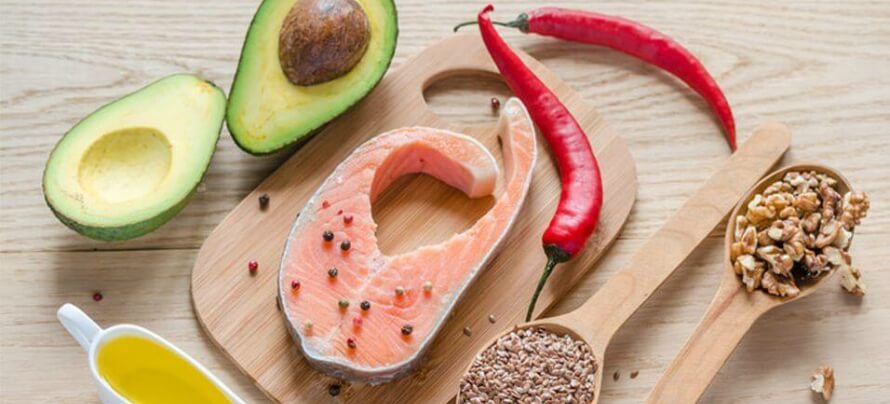
Your body uses several different nutrients for fuel.
You get the majority of your energy from carbohydrate and fat, and the rest from a combination of protein, creatine, and other compounds.
Humans are quite good at switching between different kinds of fuel, and the “mix” of carbohydrate, fat, and protein that your body uses largely depends on the composition of your diet.
If you eat more carbohydrate, you burn more carbohydrate and less fat.
If you eat more fat, you burn more fat and less carbohydrate.
Somewhere along the way, that idea was dumbed down into “eating fat burns more fat.”
That’s true, but that doesn’t tell us what kind of fat we’re burning.
If we look to the research, we see that eating more fat simply makes you burn more dietary fat, but it makes no difference in how much body fat we’re burning. A good example of this is a study conducted by Scientists at The National Institutes of Health that compared how a high-fat and high-carb diet affected fat burning and body composition.
The researchers divided people into two groups:
- The first group ate a high-fat diet that included 108 grams of fat and only 140 grams of carbs per day.
- The second group ate a high-carb diet that included 350 grams of carbs and only 17 grams of fat per day.
After 5 days, the group following the high-fat diet was burning significantly more dietary fat than the group following the high-carb diet. Their metabolisms had “switched” over to burning fat for fuel instead of carbohydrate.
According to high-fat diet proponents, this means they should be scorching through their body fat stores.
Here’s what actually happened:
The group that restricted their fat intake and ate more carbs lost more fat by the end of the study.
Other research has proven the same thing countless times. Following a high-fat diet simply deprives your body of carbohydrate, which forces it to use more fat for fuel. As long as you’re eating the same number of total calories, though, it’s going to burn dietary fat, and leave your body fat untouched.
Summary: Eating more fat only makes your body burn more dietary fat, and it has no impact on your body composition unless it helps you eat fewer calories.
Low-Carb, High-Fat Diet Myth #3: “Eating more fat helps you burn more calories”
Many claim that eating more fat gives you a “metabolic advantage.”
Gram-for-gram, they say, fat takes more calories to digest and thus raises your metabolic rate more than carbs.
You can see how this should help with weight loss.
By eating more fat and less carbs you can burn hundreds more calories per day eating the same amount of food.
Would you take that deal?

I’d take that deal.
You can finally have your (low-carb, high-fat) cake and eat it, too!
As Aldo Raine says, though, if something sounds too good to be true . . . it ain’t.
One of the best examples of this comes from a study conducted by scientists at the National Institute of Diabetes and Digestive and Kidney Diseases, which looked at how high-fat or high-carb diets affected body composition and calorie burning.
There were several phases to the study.
First, 19 men and women were randomized into two groups.
The first group followed a high-fat, low-carb diet for 6 days.
The second group followed a low-fat, high-carb diet for 6 days.
Here are the exact calories and macros for both groups:
High-Fat Diet
1900 calories
101 grams of protein
108 grams of fat
140 grams of carbs
High-Carb Diet
1900 calories
105 grams of protein
17 grams of fat
352 grams of carbs
Then, after a two to four week break, the groups switched, so that everyone who followed the high-fat diet at first followed the high-carb diet the second time around.
This way, the researchers could make sure that everyone got to experience both diets, which would lead to more accurate results.
The results?
The people who followed the high-carb diet burned more calories and lost more body fat than the people who followed the high-fat diet.
To be fair, the differences were small, but this study is one of the most airtight pieces of evidence out there that eating more fat doesn’t make you burn more calories.
Some high-fat diet proponents will tell you that other studies show different results, but there are a few things to keep in mind:
- This was one of the most well-controlled, designed, and executed studies to date. They used the most advanced measurements techniques available, they measured energy expenditure in multiple ways, and they use rigorous methods to make sure every subject towed the line.
- Many other well-designed studies have found the same thing. Reducing carbs and increasing fat either causes a small drop in calorie burning or has no effect whatsoever.
- A few studies have shown that high-fat diets increase calorie burning, but invariably, these diets also provided more protein. The increased protein was responsible for the increase in calorie burning, not the increase in dietary fat. The scientists in charge of this study knew this, which is why both groups got the same amount of protein.
Summary: High-fat, low-carb diets don’t have a metabolic advantage, they don’t help you burn more calories, and they don’t help you lose more weight than high-carb, low-fat diets.
Low-Carb, High-Fat Diet Myth #4: “Eating more fat helps you eat less.”
Hunger is always the enemy when you’re dieting.
Thus, it’s exciting when you hear people say that all you have to do to reduce your appetite is follow a high-fat diet.
Just cut out the carbs, eat more fat, and hunger and cravings are a thing of the past.
The evidence is less cut and dry, though.
Some studies show that following an extremely high-fat, low-carb diet reduces hunger and others don’t.
If low-carb diets do reduce appetite, it looks like you have to decrease your carb intake to rock bottom levels to see significant results. Evidence for this comes from a study conducted by scientists at The Boden Institute of Obesity.
They analyzed studies that put people on ketogenic diets, which typically restrict carb intake to less than 30 grams per day (while increasing fat to make up the difference).
They found that ketogenic diets can slightly decrease appetite, but the effects were small. The studies they looked at were also on obese people, who may respond better to low-carb, high-fat diets than lean people.
When you look at the research on the whole, you’ll also find that many of the studies that show high-fat diets decreased hunger also included more protein.
So really, what you’re looking at in these cases are higher-protein diets versus lower-protein diets, and it’s well known that increasing your protein intake reduces hunger.
In cases where people followed high-carb and high-fat diets with the same amount of protein, both groups experienced about the same level of hunger.
Summary: Low-carb, high-fat diets aren’t better for reducing appetite. You can still try them if you want, but you’re better off increasing your protein intake.
So, Are Low-Carb, High-Fat Diets Better for Fat Loss?
Let’s recap:
High-fat diets don’t help you . . .
- Lose weight faster
- Burn more body fat
- Burn more calories
- Eat less
. . . so they’re basically a failure at every level when it comes to fat loss.
High-fat diets can cause an initial rush of weight loss, but that’s due to a loss of water weight and glycogen, not body fat.
As scientists from the University of Toronto concluded in a review of 59 studies on high-carb versus high-fat diets:
Significant weight loss was observed with any low-carbohydrate or low-fat diet. Weight loss differences between individual named diets were small. This supports the practice of recommending any diet that a patient will adhere to in order to lose weight.
In other words, as long as you’re in a calorie deficit and eating enough protein, you should follow the diet that’s easiest for you to stick to. You’ll be able to lose just as much fat following a high-carb diet as a high-fat diet.
Low-Carb, High-Fat Diets and Building Muscle

Some claim that high-fat diets are superior to high-carb diets for building muscle.
Traditional bodybuilding lore, though, says that high-carb diets are the way to go.
And still others say that it doesn’t matter. Just drink a gallon of milk a day and don’t worry about it, brah.
To figure out who’s right, let’s first look at what makes muscles grow in the first place.
The Simple Science of Muscle Growth
The size of your muscle cells is largely dictated by how much protein they contain.
Like every other cell, your body is constantly breaking down and regenerating the proteins in your muscle cells.
The process by which proteins are created to replace degraded cells is known as protein synthesis, and the process by which cells are broken down is known as protein breakdown.
Under normal health and dietary circumstances, the cellular degradation and regeneration rates remain balanced. This is why your total lean mass remains more or less stable on a day-to-day basis.
Muscle growth is simply the process of protein synthesis remaining higher than protein breakdown over time.
Thus, strategies to increase protein synthesis and/or decrease protein degradation accelerate muscle growth. This is one of the reasons steroids are so effective for building muscle—they drastically increase protein synthesis and decrease protein breakdown.
How do you increase protein synthesis (and thus, muscle growth)?
You can read this article to get the full answer, but here are the three main takeaways:
- Eat enough calories.
- Eat enough protein.
- Do lots of heavy, compound strength training.
If you’re following a high-fat, high-protein diet, then you can manage the first two goals easily enough. Accomplishing the third goal, though, becomes much harder.
To continue stimulating protein synthesis, you need to generate greater and greater amounts of tension in your muscles. This is known as progressive tension overload, and research shows it’s the single most effective way to stimulate muscle growth.
At bottom, if you stop getting stronger, you’ll stop getting bigger.
High-fat diets can provide plenty of calories and protein, but where they fall short is fueling the kind of workouts you need to do to build muscle.
Which Is Better for Muscle Growth: High-Fat or High-Carb Diets?
During intense exercise, your muscles primarily rely on glycogen.
As you learned earlier, glycogen is a form of stored carbohydrate found in the muscles and liver, and it’s broken down into glucose and used as fuel during exercise.
Your body requires a large amount of carbohydrate to maintain its glycogen stores, which is why high-fat, low-carb diets significantly reduce glycogen levels.
You can see how this might be a problem if you’re lifting heavy weights.
Doing just 6 to 9 sets can deplete muscle glycogen levels by around 40%, and if you go into a workout with already low levels, it’s reasonable to assume you’ll struggle to lift as much weight.
And if you can’t lift as much weight, then it’s also reasonable to assume you won’t build as much muscle.
What do studies show, though?
Research goes back and forth, with most studies showing that high-fat, low-carb diets reduce athletic performance and others showing either no difference and even a few that show an increase in performance.
There are other reasons to think that high-carb diets might be superior for building muscle, though.
Research shows that glycogen availability directly influences protein synthesis and degradation rates.
Simply put: high-fat, low-carb diets result in lower levels of protein synthesis than high-carb ones.
Another way that carbs affect muscle protein balance favorably has to do with insulin production.
Insulin is a hormone released by the pancreas that shuttles nutrients from your blood into your cells.
It also has anti-catabolic properties, which means that when insulin levels are elevated, breakdown of muscle proteins is suppressed.
Now, as insulin production is stimulated by eating food, and by eating carbs in particular, it’s not surprising that people following a high-carb diet have generally higher insulin levels than people following a low-carb, high-fat one.
This is undesirable if you’re sedentary and overweight, of course. Carbs are primarily energetic and if you don’t move your body much, it has no need for excessive amounts of food energy.
Elevated insulin levels are highly desirable if you’re trying to build muscle though, because it’s a more anabolic environment in which muscles can grow larger quicker.
And this isn’t just theory, either.
Research conducted by scientists at Ball State University found that low muscle glycogen levels (which is inevitable with low-carb, high-fat dieting) impair post-workout cell signaling related to muscle growth.
Another study conducted by researchers at the University of North Carolina found that when combined with daily exercise, a low-carb, high-fat diet increased resting cortisol levels and decreased free testosterone levels.
Cortisol is a hormone that breaks down tissues, including muscle, and testosterone is the primary hormonal driver of muscle growth.
When it comes to building muscle, you want low resting cortisol and high free testosterone levels—the exact opposite of what a low-carb diet produces.
These studies help explain the findings of other studies on the matter of carbs and body composition and performance.
For example, a study conducted by researchers at the University of Rhode Island looked at how low- and high-carbohydrate intakes affected exercise-induced muscle damage, strength recovery, and whole body protein metabolism after a strenuous workout.
What they found was the subjects on the low-carbohydrate diet lost more strength, recovered slower, and showed lower levels of protein synthesis.
It’s also worth noting that the “low-carb” (and thus, high fat) group wasn’t all that low, really. They were eating about 220 grams of carbs per day versus the high-carb intake of 350 grams per day. And these effects become even more pronounced as carbs intake decreases.
Yet another study worth mentioning was conducted by researchers at McMaster University, which compared high- and low-carbohydrate dieting with subjects performing daily leg workouts.
Subjects on the low-carb diet (30% of daily calories) showed higher rates of protein breakdown and lower rates of protein synthesis than the high-carb dieters (60% of daily calories), resulting is less overall muscle growth.
The bottom line is this:
Some studies show that high-fat diets can work for building muscle, but a more ideal approach would be to follow a high-carb diet.
Specifically, I never drop my carbohydrate intake lower than about 1 gram per pound of body weight when cutting, and I’ll go as high as 3 to 4 grams per pound when bulking.
What if your goal isn’t to build muscle, though? What about high-fat diets and endurance sports?
Low-Carb, High-Fat Diets and Endurance Sports

For years, you’ve been told that carbs are the endurance athletes best friend.
Look at any magazine, book, or blog, and chances are good you’ll read about how one of the worst things you can do for your performance is follow a high-fat diet.
The tide is changing, though.
Lately, more and more people have been claiming that high-fat diets are not just workable for endurance athletes—they’re better than high-carb diets.
To understand where this idea comes from, we have to look at how your diet affects your performance.
Which Is Better for Endurance Performance: Carbs or Fats?
The body uses both fats and carbs during endurance exercise.
At low intensities your body primarily relies on fat for fuel, but the harder you work out the more you depend on carbs for fuel instead.
Your body has virtually unlimited fat stores, but a limited amount of carbohydrate (stored as glycogen). You can fully deplete glycogen levels in your legs, for instance, after about 90 to 120 minutes of hard cycling.
At that point, you have two options:
- Slow down so that you don’t need as many carbs
- Eat more carbs
High-fat dieters say there’s a third option.
They say that by following a high-fat diet, you can train your body to burn fat instead of carbs, thus tapping into an endless source of energy and freeing yourself from the need to rely on carbs.
Is that true, though?
Can You Train Your Body to Become “Fat Adapted”?
Yes, sort of.
By restricting your carbohydrate intake, you can make your body burn mostly fat instead of carbs.
This is also true during exercise, where your total energy needs are significantly greater.
Even the leanest athletes have thousands of calories stored as body fat, so theoretically becoming “fat adapted” could allow you to go much longer without needing to refuel.
It works better on paper than in practice, though.
The problem is that becoming “fat adapted” doesn’t mean that your muscles no longer benefit from carbs. It simply means that at any given intensity, you burn a slightly higher percentage of energy from fat instead of carbs.
This is fine if all of your workouts are relatively long, slow, and easy.
It’s a major issue if you ever push yourself in your workouts, though.
This is because high-intensity exercise still requires large amounts of glycogen, regardless of how “fat adapted” you are, and dietary carbohydrate is the primary source of glycogen.
Now, you might be thinking “well, endurance sports are all long, slow, and easy, so who cares?”
Not true.
We don’t need to get into the finer points of endurance physiology, but suffice to say that every single endurance sport involves bouts of higher intensity effort. Sprinting to catch up to the group in cycling. Sprinting up a hill in a triathlon. Making a hard turn when rowing.
All of these efforts require a large amount of glycogen, and when you do enough of them over the course of a race, it’s going to burn through a lot of carbohydrates.
Some scientists, coaches, and athletes have tried to get around this problem by training on a high-fat diet, and then eating more carbs leading up to the race.
Theoretically, this should give you the best of both worlds.
It hasn’t worked out that way.
Although you can improve your ability to tap into fat stores by eating more fat, you also decrease your body’s ability to process carbohydrate during exercise.
The exact mechanisms are beyond the scope of this article, but the important thing to know is that when you restrict your carbohydrate intake for long periods of time, you also change the levels of key enzymes in your muscles that are responsible for metabolizing carbohydrate.
These enzymes come back when you eat more carbs, but it takes several days or weeks.
Summary: Becoming “fat adapted” is going to decrease your performance if you’re competing in any kind of endurance sport that requires brief, intense efforts. You might be able to get away with it for long, slow events (like an ultramarathon), but most evidence still shows it’s going to produce subpar results.
Who Should Follow a High-Fat Diet and Who Shouldn’t
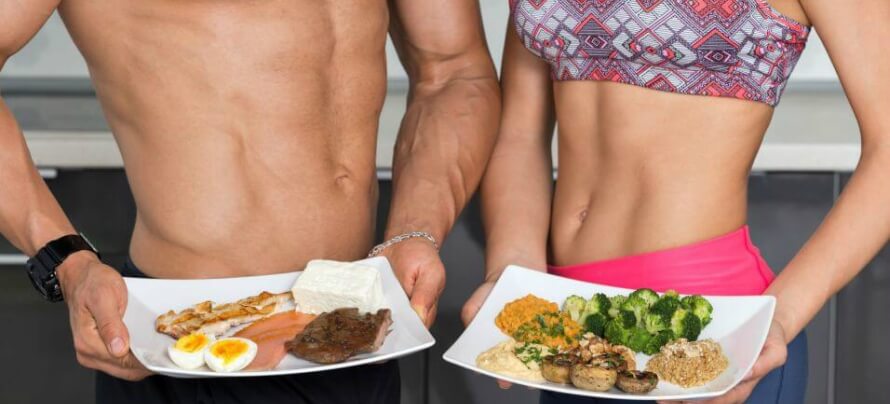
The benefits of high-fat diets are usually oversold, but that doesn’t mean they’re useless.
There are several situations where you might want to follow a high-fat diet:
You’re very overweight and sedentary.
Carbohydrates are primarily energetic—their purpose is to give our cells energy. If you don’t do anything with your body, it doesn’t need very much energy, and thus you can largely replace carbs with fat.
Thus, a relatively low-carb, high-fat diet would make sense for a sedentary person (somewhere around 100 to 150 grams of carbs per day would be plenty).
Being sedentary causes other problems that can be partially fixed with a low-carb diet.
Insulin sensitivity refers to how responsive your cells are to insulin’s signals, and insulin response—or insulin secretion—refers to how much insulin is released into your blood in response to food eaten.
Research has shown that weight loss efforts aren’t improved or impaired by insulin sensitivity or insulin resistance per se, but there’s evidence that people with poor insulin sensitivity and response may lose more weight on a low-carb diet.
For instance, a study conducted by the Tufts-New England Medical Center found that a low-glycemic load diet helped overweight adults with high insulin secretion lose more weight, but not overweight adults with low insulin secretion.
A study conducted by the University of Colorado demonstrated that obese women that were insulin sensitive lost significantly more weight on a high-carb, low-fat diet than a low-carb, high-fat diet.
On average, those following the high-carb diet lost 14% of their body weight whereas those on the low-carb diet lost just 7% of their body weight.
Those that were insulin resistant, though, lost significantly more weight on a low-carb, high-fat diet than a high-carb, low-fat diet. In this group, those on the low-carb diet lost 14% of their body weight, whereas those on the high-carb diet only lost 9% of their body weight.
Remember that this was just one study, and it’s possible new research will disprove these findings.
That said, it does seem that people who are more overweight, sedentary, and insulin-resistant might lose more weight following a high-fat, low-carb diet.
You struggle with hunger while following a high-carb diet.
High-fat diets may or may not be able to reduce hunger and cravings.
It’s far from a sure bet, but as long as you’re aware of the downsides, there’s no harm in trying.
If you’re going to do this, though, stick to these guidelines:
- Make sure you eat at least 1 gram of protein per pound of body weight.
- Make sure you eat plenty of nutritious, filling, fiber-rich vegetables.
- Make sure you track your strength levels. If you get significantly weaker, then it might not be worth it.
You’re tired of high-carb dieting and want to try something new.
If following a high-fat diet helps you stick to your diet, and you aren’t as concerned with building or maintaining muscle, then there’s nothing wrong with giving them a shot.
What’s the best way to do that, you wonder? Well, let’s take a look at what foods you’ll want to be eating.
The High-Fat Diet Menu
As you can imagine, the menu on a high-fat diet is going to be more strict than your normal fat loss diet.
Here’s a short list of foods you can eat while following a high-fat diet.
High-Fat Foods for a High-Fat Diet
As the majority of calories on a high-fat diet come from dietary fats, digestive tolerance is an important factor. Eventually, large amounts of oils and dairy can cause gastrointestinal issues.
Here’s a list of popular choices that high-fat dieters mix and match to meet their high dietary fat needs:
- Avocado
- Butter
- Chicken
- Mayonnaise
- Olives & olive oil
- Coconut meat & coconut oil
- Nuts & nut butters like peanuts, pecans, almonds, macadamias, and walnuts
- Most seed & nut oils like sesame oil, flaxseed oil, almond oil, etc.
- Whole-fat dairy like milk, heavy cream, sour cream, cottage cheese, and cream cheese (they’re fattier than they are protein-rich, so I’m including here)
High-Protein Foods for a High-Fat Diet
Although some high-fat diets are very low in both protein and carbs, modern versions generally include quite a bit of protein to preserve muscle mass and reduce hunger.
Here are the most popular choices of protein for high-fat dieting:
- Fattier cuts of red meats like beef, lamb, pork, and veal
- White meats like chicken and turkey
- Dark meat poultry like duck and goose
- Fish and seafood of all kinds like salmon, sardines, snapper, calamari, and anchovies
- Shellfish like crab, lobster, shrimp, oysters, and mussels
- Eggs
- Bacon and sausage
- Nuts and nut butters
- Protein powders
Vegetables for a High-Fat Diet
If you’re following a high-fat diet, you have to limit starchy vegetables like corn, peas, potatoes, and sweet potatoes because they’re simply too high in carbohydrate.
Even lower calorie veggies like tomatoes, carrots, peppers, and squash need to be limited.
You can include these in small amounts, but if you eat large quantities your carbohydrate intake will quickly rise above your fat intake.
Thus, the main vegetables of choice for high-fat dieting are non-starchy, like…
- Asparagus
- Bok Choy
- Broccoli
- Brussels Sprouts
- Cabbage
- Cauliflower
- Celery
- Chives
- Cucumbers
- Garlic
- Leafy greens
- Lettuces and salad greens
- Mushrooms
- Olives
- Onions
- Pickles
- Sauerkraut
- Scallions
- Shallots
- Spinach
- Sprouts of all kinds
Now that you know what you can eat, let’s look at how much to eat to reach your goals.
How to Create a Low-Carb, High-Fat Diet Plan
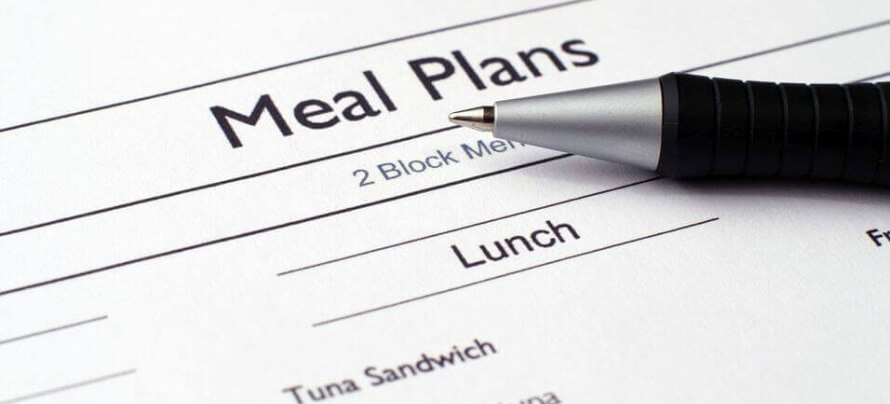
If you’re going to take a high-fat diet out for a spin, the first obstacle is creating meal plans to follow.
Here’s how to do it:
Use the following calculator to determine how much energy your body burns every day.
Enter your email so we can send them to you.Want to save your results?
The resulting number will be a fairly accurate measurement of the total amount of energy your body is burning every day, generally known as your total daily energy expenditure or TDEE.
If you ate that amount of calories every day, your weight would remain more or less the same. Thus, to reduce your weight, you have to eat less, which brings me to point three.
If you’re looking to lose weight, calculate your calorie deficit.
You’ll want to follow a moderately aggressive calorie deficit of 20 to 25%. Anything larger can cause unwanted side effects associated with “starvation dieting.”
So what this means is you want to set your daily calorie intake to 75 to 80% of your TDEE.
For example, my TDEE is about 3,000 calories, so when I want to lose weight, I set my intake to about 2,300 calories.
If you’re looking to gain weight, calculate your calorie surplus.
I recommend a slight calorie surplus of about 10% because a larger surplus isn’t going to help you build muscle faster. Instead, it will just make you gain fat faster.
Thus, set your daily calorie intake to 110% of your TDEE. For me, that’s about 3,300 calories.
Determine your macronutrient targets.
Now that you have your calorie target worked out, it’s time to turn it into protein, carbohydrate, and fat targets.
Here’s how to do it:
- If you’re in a calorie deficit, eat 1.2 grams of protein per pound of body weight. (If you’re obese, reduce this to 1 gram per pound of lean mass. Click here to learn how to calculate this.)
- If you’re in a calorie surplus, eat 1 gram of protein per pound of body weight. (If you’re obese, reduce it to the same amount as above.)
- Multiply your total grams of protein by 4. This is approximately how many calories are contained in a gram of protein.
- Start with 150 grams of carbohydrate per day, or 600 calories worth.
That’s enough carbohydrate to support mood and cognitive function, while getting the majority of your calories from fat. You can reduce the amount of carbs you eat as you acclimate to the diet if you’d like. If you want to reduce them enough to start following a high-fat, ketogenic diet, then check out this article.
- Add the calories from carbs and protein.
- Subtract this number from your total daily calories, which gives you the amount of calories you have left for your dietary fat.
- Divide this number by 9, which is the approximate amount of calories contained in a gram of fat. This number is the amount of dietary fat you need to eat each day, in grams.
Here’s how this would play out for me if I were cutting.
I weigh 180 pounds and my cutting calories are 2,300.
I need 220 grams of protein, which provides 880 calories.
Then there’s 600 calories of carbs.
That leaves me 820 calories for fat, which is 90 grams.
So, here are my daily macro targets:
2,300 calories
220 grams of protein
150 grams of carbs
90 grams of fat
So, now that you have your numbers, it’s time to turn them into a meal plan that you will enjoy.
Make a list of high-fat foods you’d like to eat every day and head over to CalorieKing to learn their macronutrient profiles. Make a list of each in Excel, noting their protein, carbohydrate, fat, and calorie numbers in side-by-side columns.
Now you need to start piecing together meals using those foods until you’re happy with the setup and your total daily intake is within 50 calories of your target.
Here are a few examples of high-fat meal plans we make for people over on this page:
Once you’ve made your plan, you now stick to it every day.
If, along the way, you get tired of a certain food or meal, simply replace it with something else you’d like to eat that fits your numbers.
It’s that simple!
The Bottom Line on Low-Carb, High-Fat Diets
High-fat diets are oversold.
They don’t offer any innate weight loss advantage, they don’t help you burn more calories or fat, and they don’t reliably help people eat fewer calories.
High-fat diets can work for building muscle, but when you look at the pros and cons high-carb diets still come out on top for most people.
And when it comes to increasing your endurance, high-fat diets are a full-blown failure.
That said, high-fat diets can work if you . . .
- Are very overweight and sedentary.
- Struggle with hunger while following a high-carb diet.
- Are tired of high-carb dieting and want to try something new.
If you don’t fall into one of those camps, though, you’re better off following a high-carb diet.
Oh, and if reading this article has got you thinking a low-carb, high-fat diet isn’t right for your circumstances and goals, then take the Legion Diet Quiz! In less than a minute, you’ll know exactly what diet is right for you. Click here to check it out.
What’s your take on high-fat diets? Have anything else to share? Let me know in the comments below!
Scientific References +
- Johnston, B. C., Kanters, S., Bandayrel, K., Wu, P., Naji, F., Siemieniuk, R. A., Ball, G. D. C., Busse, J. W., Thorlund, K., Guyatt, G., Jansen, J. P., & Mills, E. J. (2014). Comparison of weight loss among named diet programs in overweight and obese adults: A meta-analysis. JAMA - Journal of the American Medical Association, 312(9), 923–933. https://doi.org/10.1001/jama.2014.10397
- Cornier, M. A., Donahoo, W. T., Pereira, R., Gurevich, I., Westergren, R., Enerback, S., Eckel, P. J., Goalstone, M. L., Hill, J. O., Eckel, R. H., & Draizin, B. (2005). Insulin sensitivity determines the effectiveness of dietary macronutrient composition on weight loss in obese women. Obesity Research, 13(4), 703–709. https://doi.org/10.1038/oby.2005.79
- Pittas, A. G., Das, S. K., Hajduk, C. L., Golden, J., Saltzman, E., Stark, P. C., Greenberg, A. S., & Roberts, S. B. (2005). A low-glycemic load diet facilitates greater weight loss in overweight adults with high insulin secretion but not in overweight adults with low insulin secretion in the CALERIE trial. Diabetes Care, 28(12), 2939–2941. https://doi.org/10.2337/diacare.28.12.2939
- Mcclain, A. D., Otten, J. J., Hekler, E. B., & Gardner, C. D. (2013). Adherence to a low-fat vs. low-carbohydrate diet differs by insulin resistance status. In Diabetes, Obesity and Metabolism (Vol. 15, Issue 1, pp. 87–90). Blackwell Publishing Ltd. https://doi.org/10.1111/j.1463-1326.2012.01668.x
- A de Luis, D., Aller, R., Izaola, O., Gonzalez Sagrado, M., & Conde, R. (2006). Differences in glycaemic status do not predict weight loss in response to hypocaloric diets in obese patients. Clinical Nutrition, 25(1), 117–122. https://doi.org/10.1016/j.clnu.2005.09.009
- Peters, S. J., Harris, R. A., Wu, P., Pehleman, T. L., Heigenhauser, G. J. F., & Spriet, L. L. (2001). Human skeletal muscle PDH kinase activity and isoform expression during a 3-day high-fat/low-carbohydrate diet. American Journal of Physiology - Endocrinology and Metabolism, 281(6 44-6). https://doi.org/10.1152/ajpendo.2001.281.6.e1151
- Burke, L. M., Angus, D. J., Cox, G. R., Cummings, N. K., Febbraio, M. A., Gawthorn, K., Hawley, J. A., Minehan, M., Martin, D. T., & Hargreaves, M. (2000). Effect of fat adaptation and carbohydrate restoration on metabolism and performance during prolonged cycling. Journal of Applied Physiology, 89(6), 2413–2421. https://doi.org/10.1152/jappl.2000.89.6.2413
- Faria, E. W., Parker, D. L., & Faria, I. E. (2005). The science of cycling: Physiology and training - Part 1. In Sports Medicine (Vol. 35, Issue 4, pp. 285–312). Sports Med. https://doi.org/10.2165/00007256-200535040-00002
- Burke, L. M. (2015). Re-Examining High-Fat Diets for Sports Performance: Did We Call the ‘Nail in the Coffin’ Too Soon? In Sports Medicine (Vol. 45, Issue Suppl 1, pp. 33–49). Springer International Publishing. https://doi.org/10.1007/s40279-015-0393-9
- Jentjens, R., & Jeukendrup, A. E. (2003). Determinants of post-exercise glycogen synthesis during short-term recovery. In Sports Medicine (Vol. 33, Issue 2, pp. 117–144). Sports Med. https://doi.org/10.2165/00007256-200333020-00004
- Van Loon, L. J. C., Greenhaff, P. L., Constantin-Teodosiu, D., Saris, W. H. M., & Wagenmakers, A. J. M. (2001). The effects of increasing exercise intensity on muscle fuel utilisation in humans. Journal of Physiology, 536(1), 295–304. https://doi.org/10.1111/j.1469-7793.2001.00295.x
- University of Rochester. (n.d.). Free Testosterone - Health Encyclopedia - University of Rochester Medical Center. Retrieved May 12, 2021, from https://www.urmc.rochester.edu/encyclopedia/content.aspx?ContentTypeID=167&ContentID=testosterone_free
- Lane, A. R., Duke, J. W., & Hackney, A. C. (2010). Influence of dietary carbohydrate intake on the free testosterone: Cortisol ratio responses to short-term intensive exercise training. European Journal of Applied Physiology, 108(6), 1125–1131. https://doi.org/10.1007/s00421-009-1220-5
- Creer, A., Gallagher, P., Slivka, D., Jemiolo, B., Fink, W., & Trappe, S. (2005). Influence of muscle glycogen availability on ERK1/2 and Akt signaling after resistance exercise in human skeletal muscle. Journal of Applied Physiology, 99(3), 950–956. https://doi.org/10.1152/japplphysiol.00110.2005
- Noakes, M., Foster, P. R., Keogh, J. B., James, A. P., Mamo, J. C., & Clifton, P. M. (2006). Comparison of isocaloric very low carbohydrate/high saturated fat and high carbohydrate/low saturated fat diets on body composition and cardiovascular risk. Nutrition and Metabolism, 3. https://doi.org/10.1186/1743-7075-3-7
- Denne, S. C., Liechty, E. A., Liu, Y. M., Brechtel, G., & Baron, A. D. (1991). Proteolysis in skeletal muscle and whole body in response to euglycemic hyperinsulinemia in normal adults. American Journal of Physiology - Endocrinology and Metabolism, 261(6 24-6). https://doi.org/10.1152/ajpendo.1991.261.6.e809
- Gelfand, R. A., & Barrett, E. J. (1987). Effect of physiologic hyperinsulinemia on skeletal muscle protein synthesis and breakdown in man. Journal of Clinical Investigation, 80(1), 1–6. https://doi.org/10.1172/JCI113033
- Howarth, K. R., Phillips, S. M., MacDonald, M. J., Richards, D., Moreau, N. A., & Gibala, M. J. (2010). Effect of glycogen availability on human skeletal muscle protein turnover during exercise and recovery. Journal of Applied Physiology, 109(2), 431–438. https://doi.org/10.1152/japplphysiol.00108.2009
- Lambert, E. V., Goedecke, J. H., Van Zyl, C., Murphy, K., Hawley, J. A., Dennis, S. C., & Noakes, T. D. (2001). High-fat diet versus habitual diet prior to carbohydrate loading: Effects on exercise metabolism and cycling performance. International Journal of Sport Nutrition, 11(2), 209–225. https://doi.org/10.1123/ijsnem.11.2.209
- Carey, A. L., Staudacher, H. M., Cummings, N. K., Stepto, N. K., Nikolopoulos, V., Burke, L. M., & Hawley, J. A. (2001). Effects of fat adaptation and carbohydrate restoration on prolonged endurance exercise. Journal of Applied Physiology, 91(1), 115–122. https://doi.org/10.1152/jappl.2001.91.1.115
- Burke, L. M., Hawley, J. A., Angus, D. J., Cox, G. R., Clark, S. A., Cummings, N. K., Desbrow, B., & Hargreaves, M. (2002). Adaptations to short-term high-fat diet persist during exercise despite high carbohydrate availability. Medicine and Science in Sports and Exercise, 34(1), 83–91. https://doi.org/10.1097/00005768-200201000-00014
- Burke, L. M., & Kiens, B. (2006). “Fat adaptation” for athletic performance: The nail in the coffin? In Journal of Applied Physiology (Vol. 100, Issue 1, pp. 7–8). J Appl Physiol (1985). https://doi.org/10.1152/japplphysiol.01238.2005
- GALBO, H., HOLST, J. J., & CHRISTENSEN, N. J. (1979). The effect of different diets and of insulin on the hormonal response to prolonged exercise. Acta Physiologica Scandinavica, 107(1), 19–32. https://doi.org/10.1111/j.1748-1716.1979.tb06438.x
- Havemann, L., West, S. J., Goedecke, J. H., Macdonald, I. A., St Clair Gibson, A., Noakes, T. D., & Lambert, E. V. (2006). Fat adaptation followed by carbohydrate loading compromises high-intensity sprint performance. Journal of Applied Physiology, 100(1), 194–202. https://doi.org/10.1152/japplphysiol.00813.2005
- Robergs, R. A., Pearson, D. R., Costill, D. L., Fink, W. J., Pascoe, D. D., Benedict, M. A., Lambert, C. P., & Zachweija, J. J. (1991). Muscle glycogenolysis during differing intensities of weight-resistance exercise. Journal of Applied Physiology, 70(4), 1700–1706. https://doi.org/10.1152/jappl.1991.70.4.1700
- Winwood-Smith, H. S., Franklin, C. E., & White, C. R. (2017). Low-carbohydrate diet induces metabolic depression: A possible mechanism to conserve glycogen. American Journal of Physiology - Regulatory Integrative and Comparative Physiology, 313(4), R347–R356. https://doi.org/10.1152/ajpregu.00067.2017
- Price, T. B., & Sanders, K. (2017). Muscle and liver glycogen utilization during prolonged lift and carry exercise: male and female responses. Physiological Reports, 5(4). https://doi.org/10.14814/phy2.13113
- Schoenfeld, B. J. (2010). The mechanisms of muscle hypertrophy and their application to resistance training. In Journal of Strength and Conditioning Research (Vol. 24, Issue 10, pp. 2857–2872). J Strength Cond Res. https://doi.org/10.1519/JSC.0b013e3181e840f3
- Chargé, S. B. P., & Rudnicki, M. A. (2004). Cellular and Molecular Regulation of Muscle Regeneration. In Physiological Reviews (Vol. 84, Issue 1, pp. 209–238). Physiol Rev. https://doi.org/10.1152/physrev.00019.2003
- Johnston, C. S., Tjonn, S. L., Swan, P. D., White, A., Hutchins, H., & Sears, B. (2006). Ketogenic low-carbohydrate diets have no metabolic advantage over nonketogenic low-carbohydrate diets. American Journal of Clinical Nutrition, 83(5), 1055–1061. https://doi.org/10.1093/ajcn/83.5.1055
- Halton, T. L., & Hu, F. B. (2004). The effects of high protein diets on thermogenesis, satiety and weight loss: A critical review. Journal of the American College of Nutrition, 23(5), 373–385. https://doi.org/10.1080/07315724.2004.10719381
- Soenen, S., Bonomi, A. G., Lemmens, S. G. T., Scholte, J., Thijssen, M. A. M. A., Van Berkum, F., & Westerterp-Plantenga, M. S. (2012). Relatively high-protein or “low-carb” energy-restricted diets for body weight loss and body weight maintenance? Physiology and Behavior, 107(3), 374–380. https://doi.org/10.1016/j.physbeh.2012.08.004
- Gibson, A. A., Seimon, R. V., Lee, C. M. Y., Ayre, J., Franklin, J., Markovic, T. P., Caterson, I. D., & Sainsbury, A. (2015). Do ketogenic diets really suppress appetite? A systematic review and meta-analysis. Obesity Reviews, 16(1), 64–76. https://doi.org/10.1111/obr.12230
- Wycherley, T. P., Moran, L. J., Clifton, P. M., Noakes, M., & Brinkworth, G. D. (2012). Effects of energy-restricted high-protein, low-fat compared with standard-protein, low-fat diets: A meta-analysis of randomized controlled trials. American Journal of Clinical Nutrition, 96(6), 1281–1298. https://doi.org/10.3945/ajcn.112.044321
- Ebbeling, C. B., Swain, J. F., Feldman, H. A., Wong, W. W., Hachey, D. L., Garcia-Lago, E., & Ludwig, D. S. (2012). Effects of dietary composition on energy expenditure during weight-loss maintenance. JAMA - Journal of the American Medical Association, 307(24), 2627–2634. https://doi.org/10.1001/jama.2012.6607
- Hall, K. D., Bemis, T., Brychta, R., Chen, K. Y., Courville, A., Crayner, E. J., Goodwin, S., Guo, J., Howard, L., Knuth, N. D., Miller, B. V., Prado, C. M., Siervo, M., Skarulis, M. C., Walter, M., Walter, P. J., & Yannai, L. (2015). Calorie for calorie, dietary fat restriction results in more body fat loss than carbohydrate restriction in people with obesity. Cell Metabolism, 22(3), 427–436. https://doi.org/10.1016/j.cmet.2015.07.021
- Thomas, C. D., Peters, J. C., Reed, G. W., Abumrad, N. N., Sun, M., & Hill, J. O. (1992). Nutrient balance and energy expenditure during ad libitum feeding of high- fat and high-carbohydrate diets in humans. American Journal of Clinical Nutrition, 55(5), 934–942. https://doi.org/10.1093/ajcn/55.5.934
- Hurni, M., Burnand, B., Pittet, P., & Jequier, E. (1982). Metabolic effects of a mixed and a high-carbohydrate low-fat diet in man, measured over 24 h in a respiration chamber. British Journal of Nutrition, 47(1), 33–43. https://doi.org/10.1079/bjn19820006
- Galgani, J., & Ravussin, E. (2008). Energy metabolism, fuel selection and body weight regulation. In International Journal of Obesity (Vol. 32, Issue SUPPL. 7, p. S109). NIH Public Access. https://doi.org/10.1038/ijo.2008.246
- Hall, K. D., Bemis, T., Brychta, R., Chen, K. Y., Courville, A., Crayner, E. J., Goodwin, S., Guo, J., Howard, L., Knuth, N. D., Miller, B. V., Prado, C. M., Siervo, M., Skarulis, M. C., Walter, M., Walter, P. J., & Yannai, L. (2015). Calorie for calorie, dietary fat restriction results in more body fat loss than carbohydrate restriction in people with obesity. Cell Metabolism, 22(3), 427–436. https://doi.org/10.1016/j.cmet.2015.07.021
- Davy, K. P., Horton, T., Davy, B. M., Bessessen, D., & Hill, J. O. (2001). Regulation of macronutrient balance in healthy young and older men. International Journal of Obesity, 25(10), 1497–1502. https://doi.org/10.1038/sj.ijo.0801718
- Abbott, W. G. H., Howard, B. V., Christin, L., Freymond, D., Lillioja, S., Boyce, V. L., Anderson, T. E., Bogardus, C., & Ravussin, E. (1988). Short-term energy balance: Relationship with protein, carbohydrate, and fat balances. American Journal of Physiology - Endocrinology and Metabolism, 255(3 (18/3)). https://doi.org/10.1152/ajpendo.1988.255.3.e332
- Naude, C. E., Schoonees, A., Senekal, M., Young, T., Garner, P., & Volmink, J. (2014). Low carbohydrate versus isoenergetic balanced diets for reducing weight and cardiovascular risk: A systematic review and meta-analysis. In PLoS ONE (Vol. 9, Issue 7). Public Library of Science. https://doi.org/10.1371/journal.pone.0100652
- Sacks, F. M., Bray, G. A., Carey, V. J., Smith, S. R., Ryan, D. H., Anton, S. D., McManus, K., Champagne, C. M., Bishop, L. M., Laranjo, N., Leboff, M. S., Rood, J. C., de Jonge, L., Greenway, F. L., Loria, C. M., Obarzanek, E., & Williamson, D. A. (2009). Comparison of Weight-Loss Diets with Different Compositions of Fat, Protein, and Carbohydrates. New England Journal of Medicine, 360(9), 859–873. https://doi.org/10.1056/nejmoa0804748
- Thomson, C. A., Stopeck, A. T., Bea, J. W., Cussler, E., Nardi, E., Frey, G., & Thompson, P. A. (2010). Changes in body weight and metabolic indexes in overweight breast cancer survivors enrolled in a randomized trial of low-fat vs. reduced carbohydrate diets. Nutrition and Cancer, 62(8), 1142–1152. https://doi.org/10.1080/01635581.2010.513803
- Phillips, S. A., Jurva, J. W., Syed, A. Q., Syed, A. Q., Kulinski, J. P., Pleuss, J., Hoffmann, R. G., & Gutterman, D. D. (2008). Benefit of low-fat over low-carbohydrate diet on endothelial health in obesity. Hypertension, 51(2), 376–382. https://doi.org/10.1161/HYPERTENSIONAHA.107.101824
- Manninen, A. H. (2004). Is a Calorie Really a Calorie? Metabolic Advantage of Low-Carbohydrate Diets. Journal of the International Society of Sports Nutrition, 1(2), 21. https://doi.org/10.1186/1550-2783-1-2-21
- Feinman, R. D., & Fine, E. J. (2003). Thermodynamics and Metabolic Advantage of Weight Loss Diets. Metabolic Syndrome and Related Disorders, 1(3), 209–219. https://doi.org/10.1089/154041903322716688
- Volek, J. S., Sharman, M. J., Gómez, A. L., Judelson, D. A., Rubin, M. R., Watson, G., Sokmen, B., Silvestre, R., French, D. N., & Kraemer, W. J. (2004). Comparison of energy-restricted very low-carbohydrate and low-fat diets on weight loss and body composition in overweight men and women. Nutrition and Metabolism, 1, 13. https://doi.org/10.1186/1743-7075-1-13
- Yancy, W. S., Olsen, M. K., Guyton, J. R., Bakst, R. P., & Westman, E. C. (2004). A Low-Carbohydrate, Ketogenic Diet versus a Low-Fat Diet to Treat Obesity and Hyperlipidemia: A Randomized, Controlled Trial. Annals of Internal Medicine, 140(10). https://doi.org/10.7326/0003-4819-140-10-200405180-00006
- Osterberg, K. L., Pallardy, S. E., Johnson, R. J., & Horswill, C. A. (2010). Carbohydrate exerts a mild influence on fluid retention following exercise-induced dehydration. Journal of Applied Physiology, 108(2), 245–250. https://doi.org/10.1152/japplphysiol.91275.2008
- Sherman, W. M., Costill, D. L., Fink, W. J., & Miller, J. M. (1981). Effect of exercise-diet manipulation on muscle glycogen and its subsequent utilization during performance. International Journal of Sports Medicine, 2(2), 114–118. https://doi.org/10.1055/s-2008-1034594
- Jensen, J., Rustad, P. I., Kolnes, A. J., & Lai, Y. C. (2011). The role of skeletal muscle glycogen breakdown for regulation of insulin sensitivity by exercise. In Frontiers in Physiology: Vol. 2 DEC. Front Physiol. https://doi.org/10.3389/fphys.2011.00112
- Acheson, K. J., Schutz, Y., Bessard, T., Anantharaman, K., Flatt, J. P., & Jequier, E. (1988). Glycoprotein storage capacity and de novo lipogenesis during massive carbohydrate overfeeding in man. American Journal of Clinical Nutrition, 48(2), 240–247. https://doi.org/10.1093/ajcn/48.2.240
- Kreitzman, S. N., Coxon, A. Y., & Szaz, K. F. (1992). Glycogen storage: Illusions of easy weight loss, excessive weight regain, and distortions in estimates of body composition. American Journal of Clinical Nutrition, 56(1 SUPPL.). https://doi.org/10.1093/ajcn/56.1.292S
- Samaha, F. F., Iqbal, N., Seshadri, P., Chicano, K. L., Daily, D. A., McGrory, J., Williams, T., Williams, M., Gracely, E. J., & Stern, L. (2003). A Low-Carbohydrate as Compared with a Low-Fat Diet in Severe Obesity. New England Journal of Medicine, 348(21), 2074–2081. https://doi.org/10.1056/nejmoa022637
